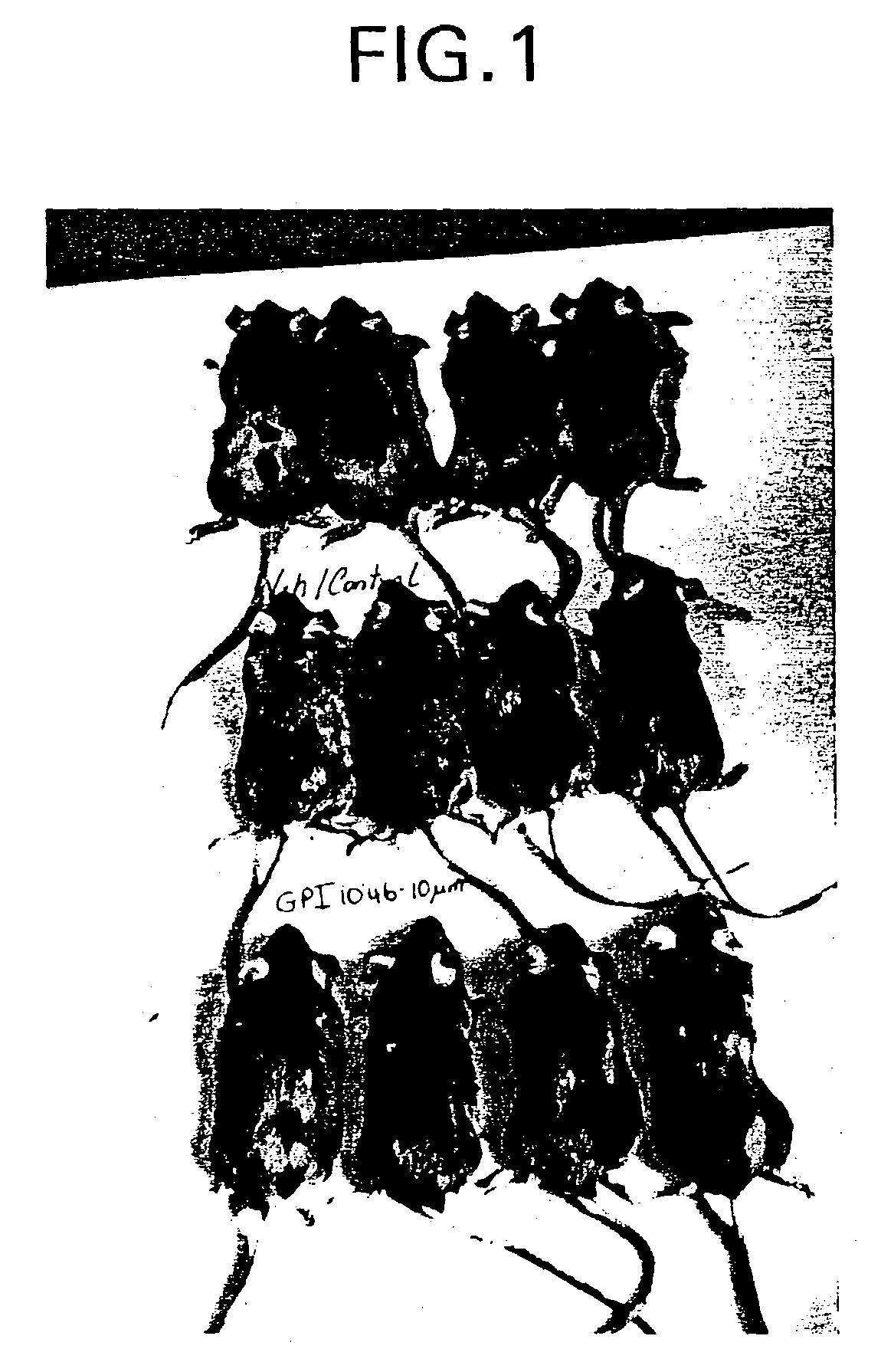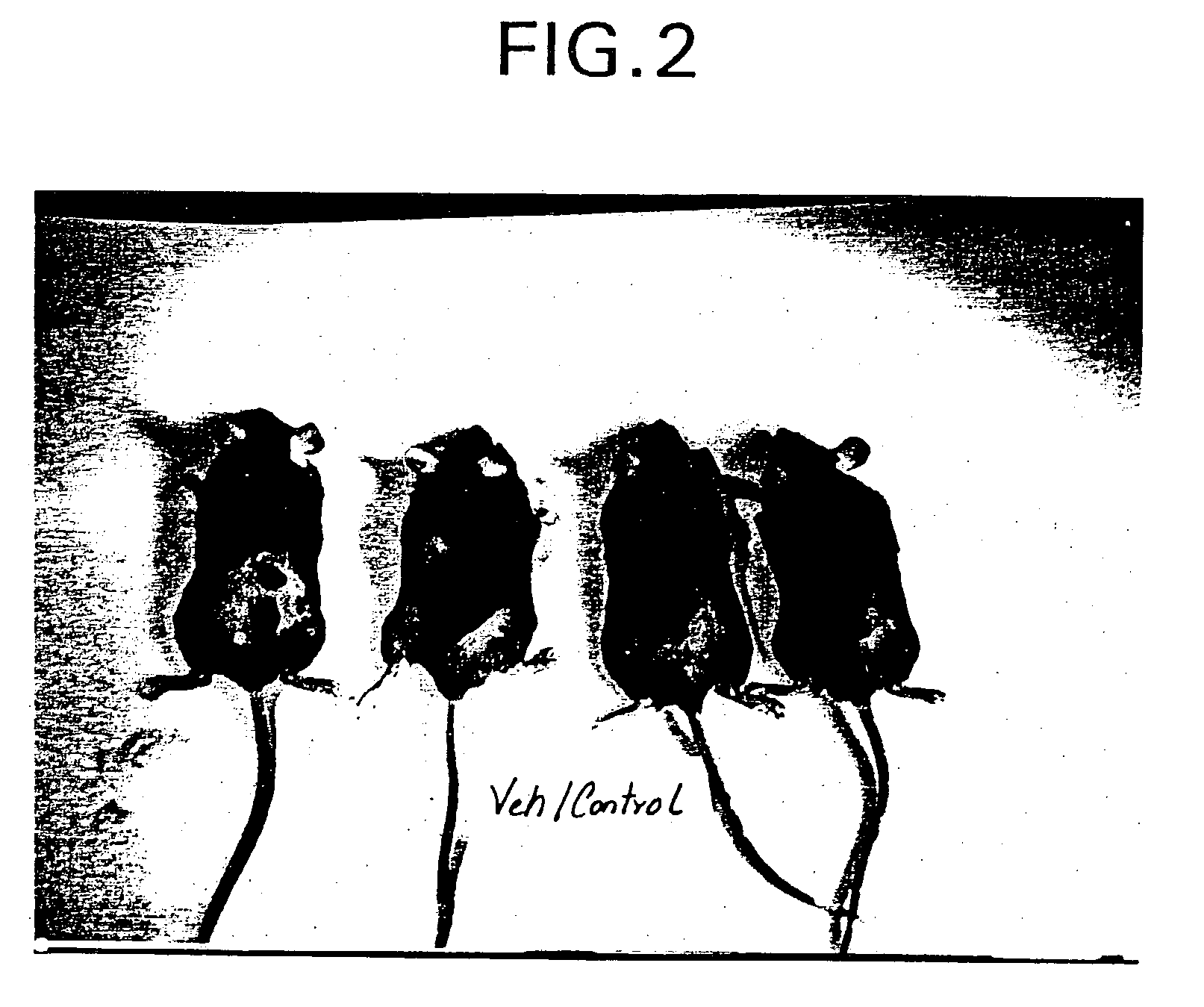N-linked sulfonamides of N-heterocyclic carboxylic acids or carboxylic acid isosteres
a technology of carboxylic acid and n-heterocyclic carboxylic acid, which is applied in the field of small molecule compounds and compositions, can solve the problems of affecting the clinical application of these proteins in various neurological disease states, immunosuppressants exhibit a number of potentially serious side effects, and the mechanism of hair loss is very complicated, so as to promote hair growth and promote hair growth
- Summary
- Abstract
- Description
- Claims
- Application Information
AI Technical Summary
Benefits of technology
Problems solved by technology
Method used
Image
Examples
example 1
Synthesis of (2S)-N-(benzylsulfonyl)-2-pyrrolidinecarboxylic Acid (Table I Compound 1) (Table II and Scheme I Compound A)
[0159]To a cooled (0° C.) solution of proline methyl ester hydrochloride salt (5.0 g; 30.19 mmol) in 200 mL of methylene chloride was added triethylamine (35 mL) and benzenesulfonyl chloride (5.75 g; 30.19 mmol). The mixture was stirred for one hour at 0° C. and then washed with 2×100 mL of water. The organic phase was dried and concentrated. Chromatography eluting with 50% EtOAc / hexane delivered 8.14 g (5%) of the N-sulfonamide methyl ester, which was dissolved in 120 mL of methanol, cooled to 0° C., and treated with 40 mL of 1 N lithium hydroxide. The mixture was stirred for 1 hour at 0° C. and then overnight at room temperature. After making the reaction mixture acidic (pH 1) with 1 N HCl, the product was extracted into metylene chloride and dried and concentrated to yield 4.25 g of (2S)-N-(benzylsulfonyl)-2-pyrrolidinecarboxylic acid (A) as a white solid, 1H N...
example 2
Synthesis of (2S)-1-(phenylmethylsulfonyl)-2-hydroxymethyl pyrrolidine (Compound 95) (Scheme III Compound E)
[0160]To a solution of (S)-(+)-2-pyrrolidinemethyanol (1.01 g, 10 mmol) and triethylamine (1.5 ml, 11 mmol) in 30 ml methylene chloride was added 1.9 g (10 mmol) α-toluenesulfonyl chloride at 0° C. with stirring. The reaction was gradually warmed up to room temperature and stirred overnight. The mixture was diluted with water, and extracted into 200 ml methylene chloride. The organic extract was concentrated and further purified by silica gel to give 1.5 g product as a white solid (58.9% yield). 1H NMR (CDCl3): d 01.71–1.88 (m, 4H); 2.05 (br, 1H, OH); 3.22 (m, 2H); 3.47 (m, 2H); 3.67 (m, 1H); 4.35 (s, 2H); 7.26–7.44 (m, 5H, aromatic).
example 3
Synthesis of (2S)-1-(phenylmethyl)sulfonyl-2-pyrrolidinecarboxamide (Compound 96) (Scheme II Compound B)
[0161]To a solution of L-prolinamde (2.28 g, 20 mmol) and triethylamine (5.76 ml, 42 mmol) in 40 ml methylene chloride was added 3.92 g (20 mmol) α-toluenesulfonyl chloride at 0° C. with stirring. The reaction was gradually warmed up to room temperature and stirred overnight. The mixture was diluted with water, and extracted into 200 ml methylene chloride. The organic extract was concentrated and further purified by silica gel to give 3.0 g product as a white solid (55.7% yield). 1H NMR (CDCl3): d 01.89 (m, 3H); 2.25 (m, 1H); 3.40 (m, 1H); 3.50 (m, 1H); 3.96 (m, 1H); 4.35 (s, 2H); 7.39–7.45 (m, 5H, aromatic).
PUM
| Property | Measurement | Unit |
|---|---|---|
| temperature | aaaaa | aaaaa |
| temperature | aaaaa | aaaaa |
| concentrations | aaaaa | aaaaa |
Abstract
Description
Claims
Application Information
 Login to View More
Login to View More - R&D
- Intellectual Property
- Life Sciences
- Materials
- Tech Scout
- Unparalleled Data Quality
- Higher Quality Content
- 60% Fewer Hallucinations
Browse by: Latest US Patents, China's latest patents, Technical Efficacy Thesaurus, Application Domain, Technology Topic, Popular Technical Reports.
© 2025 PatSnap. All rights reserved.Legal|Privacy policy|Modern Slavery Act Transparency Statement|Sitemap|About US| Contact US: help@patsnap.com



